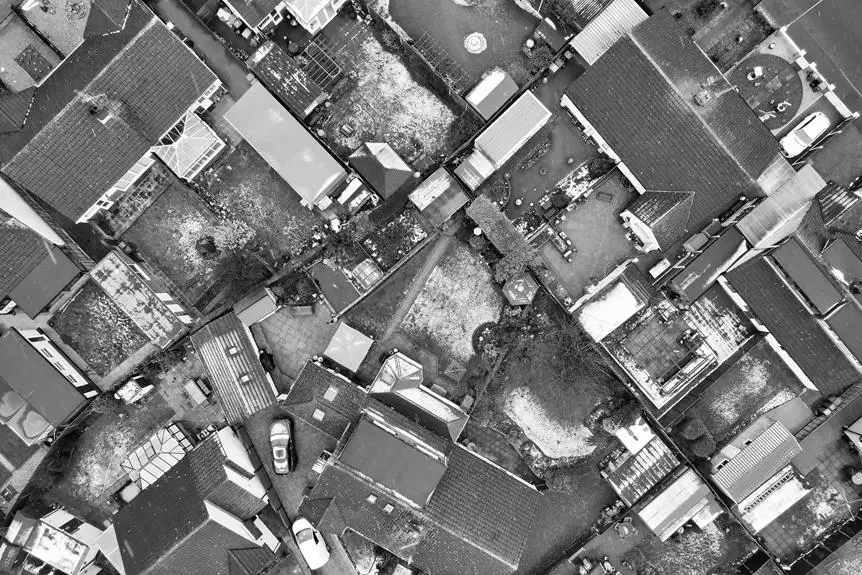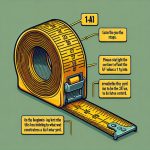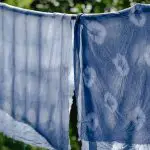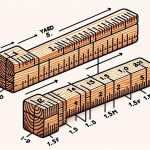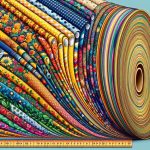Have you ever wondered if you can convert linear yards to regular yards? The answer is a resounding 'yes!'
Understanding the difference between linear yards and regular yards can be key to mastering yardage conversions. You'll find that the process is straightforward and can be applied in a variety of real-life situations.
In this guide, we'll cover the simple conversion equation, tips for accurate yardage conversion, handling fractional yardage, and even converting between square yards and linear yards.
By the end, you'll feel confident in your ability to seamlessly convert linear yards to regular yards, making your projects a breeze.
Let's dive in and master this essential skill together!
Key Takeaways
- Linear yards refer to the straight-line distance between two points, while regular yards are the standard units of length used for general measurements.
- One linear yard is equal to one regular yard if the fabric is 36 inches wide, but if the fabric is wider, yardage conversion techniques are needed.
- To convert linear yards to regular yards, multiply the linear yardage by the width of the fabric in yards.
- Accurate measurements and calculations are crucial for fabric purchasing, cutting, and optimizing material usage in fabricating projects.
Understanding Linear Yards Vs. Regular Yards
When converting linear yards to regular yards, it's important to understand the difference between the two measurements.
Linear measurement refers to the straight-line distance between two points, commonly used for fabrics, ribbons, or trims. Regular yards, on the other hand, are the standard units of length used for general measurements.
To convert linear yards to regular yards, you need to consider the width of the fabric. If the fabric is 36 inches wide, then one linear yard is equal to one regular yard.
However, if the fabric is wider, you'll need to use yardage conversion techniques to calculate the regular yardage. For instance, if the fabric is 45 inches wide, one linear yard would be equal to 1.25 regular yards.
Understanding these nuances is essential for accurate measurement and purchase. By mastering yardage conversion techniques, you can confidently navigate through different fabric widths and make precise calculations for your sewing or crafting projects.
This understanding won't only save you time and money but also ensure that you have the right amount of fabric for your creations.
The Simple Conversion Equation
To convert linear yards to regular yards, simply multiply the linear yardage by the width of the fabric in yards. This straightforward calculation allows you to accurately determine the equivalent regular yardage for your sewing or crafting needs.
When working with yardage conversion techniques, keep in mind the following:
- Understanding the fabric width: Measure the width of the fabric in yards to ensure precision in your conversion.
- Accounting for seam allowances: Consider the additional yardage needed for seam allowances, especially in projects requiring multiple pieces of fabric.
- Calculating for pattern repeats: If your project involves patterns with repeats, calculate yardage accordingly to match the pattern seamlessly.
- Adjusting for directional prints: For fabrics with directional prints, account for the additional yardage required to ensure the prints align properly.
- Considering fabric nap and layout: Factor in the fabric nap and layout when calculating yardage to ensure the desired look and feel of the finished project.
Mastering these yardage measurement challenges will empower you to accurately convert linear yards to regular yards for all your creative endeavors.
Calculating Linear Yards to Regular Yards
So, how do you actually calculate linear yards to regular yards?
It's simpler than you might think! We'll break down the conversion formula for you, provide practical examples for clarity, and discuss the importance of this conversion in fabricating projects.
Let's get started!
Conversion Formula Explained
How do you calculate regular yards from linear yards?
The formula to convert linear yards to regular yards is straightforward. To convert linear yards to regular yards, you can use the following formula:
- Regular Yards = Linear Yards / Width of Fabric
- Ensure that the width of the fabric is in yards to maintain consistency in the units.
- Always double-check your calculations to maintain yardage accuracy.
- Remember that this conversion method is particularly useful when you're dealing with materials sold by the linear yard but need to determine the amount required in standard, regular yards.
- It's essential to be precise in your calculations to avoid any shortages or excess materials.
Understanding and applying this conversion formula will help you accurately determine the regular yards needed from linear yards for any project.
Practical Examples for Clarity
Calculating linear yards to regular yards is a fundamental skill for anyone working with fabric. Let's dive into practical examples to bring clarity to fabric measurement and yardage conversion.
Say you have 5 linear yards of fabric and want to know how many regular yards that equals. Since linear yards are used for measuring length and regular yards for measuring area, you'll need to convert.
If the fabric is 60 inches wide, 5 linear yards would be 15 regular yards. This is because 5 yards * 3 feet * 12 inches = 180 inches, and 180 inches / 36 inches = 5 regular yards.
Understanding this conversion is crucial for accurate fabric purchasing and cutting. Practice different scenarios to solidify your yardage conversion skills, ensuring confidence in handling fabric measurements.
Importance in Fabricating Projects
Understanding the conversion from linear yards to regular yards is essential for accurately determining fabric quantities for your projects. Fabrication techniques and material efficiency are crucial considerations when working on any project. Here's why mastering this conversion is important:
- Optimizing Material Usage: Converting linear yards to regular yards allows you to efficiently utilize fabric, minimizing waste and reducing costs.
- Precise Project Planning: Accurate fabric quantity calculations ensure that you have the right amount of material for your fabrication projects, eliminating the risk of running short.
- Professionalism in Execution: Mastering this conversion demonstrates your expertise and attention to detail, reflecting positively on your fabricating skills.
- Cost-Effective Approach: By converting linear yards to regular yards, you can ensure that you're getting the most value out of the fabric you purchase.
- Enhanced Project Accuracy: Properly calculating regular yards from linear yards contributes to the overall precision and quality of your work.
Converting Linear Yards in Practice
You can convert linear yards to regular yards by simply multiplying the measurement in linear yards by 3, since a linear yard is equivalent to 3 feet. This conversion is particularly useful in practical applications such as fabric measurement.
Say you have 5 linear yards of fabric, and you want to know how many regular yards that would be. By applying the conversion factor, you'd multiply 5 linear yards by 3, giving you 15 regular yards of fabric.
Whether you're working on a sewing project, purchasing fabric, or planning a home improvement task, understanding how to convert linear yards to regular yards is essential. It allows for accurate measurements and helps ensure you purchase the right amount of fabric for your project, saving time and money.
Mastering this conversion will empower you to confidently navigate various projects involving fabric and other linear measurements. By simply multiplying by 3, you can easily convert linear yards to regular yards, making your fabric calculations a breeze.
Tips for Accurate Yardage Conversion
When it comes to converting linear yards to regular yards, accuracy is key.
To ensure precise calculations, it's important to understand the differences between linear and regular yards and how to make the conversion correctly.
Linear to Regular Yards
To accurately convert linear yards to regular yards, use a simple mathematical formula. First, understand that linear yards measure the length of a piece of fabric, while regular yards measure the area. Here are some tips for accurate yardage conversion:
- Understand the Difference: Linear yards measure the length of the fabric, while regular yards measure the area, so conversion involves a simple calculation.
- Know the Formula: To convert linear yards to regular yards, multiply the length in linear yards by the width in yards.
- Take Accurate Measurements: Ensure you measure the fabric's length and width correctly to get an accurate conversion.
- Use a Calculator: For precision, use a calculator to avoid any calculation errors.
- Round Up: If the result isn't a whole number, round up to the nearest whole number for accurate yardage estimation.
Calculating Yardage Accurately
Wondering how to accurately calculate yardage when converting linear yards to regular yards? Calculating accuracy is crucial for any fabrication projects.
To ensure precise measurements, remember to convert linear yards to regular yards by considering the fabric width. Measure the width of the fabric in inches and divide by 36 to convert it to yards. Then, multiply the number of linear yards by the width to obtain the total square yards.
Additionally, always account for shrinkage when working with certain fabrics. It's advisable to purchase a little extra fabric to accommodate potential shrinkage and cutting mistakes.
Handling Fractional Yardage
You frequently encounter fractional yardage when working with fabric, and it's important to know how to handle it accurately in your measurements. When dealing with fractional yardage, precision is crucial to ensure you have the right amount of fabric for your project.
Here are some key tips for handling fractional yardage:
- Understanding Fractions: Familiarize yourself with basic fractional values, such as 1/4, 1/2, and 3/4 yards, as these are common measurements in fabric.
- Rounding Up: When calculating yardage, consider rounding up to the nearest fraction to ensure you have enough fabric for your project. Rounding up also accounts for any discrepancies in measurements.
- Accounting for Waste: Keep in mind that certain projects may require extra fabric for pattern matching, aligning prints, or correcting mistakes. It's wise to factor in a buffer for these potential wastages.
- Using Decimal Equivalents: Converting fractional yardage to decimal equivalents can make calculations easier and more precise, especially when working with complex measurements.
- Double-Checking Calculations: Always double-check your calculations to avoid errors, as even small mistakes can lead to significant fabric shortages.
Converting Between Square Yards and Linear Yards
Understanding the process of converting between square yards and linear yards is essential for accurately determining fabric quantities for your projects. When dealing with fabric measurement, it's important to know how to convert between linear yards and square yards, especially when you need to purchase or cut fabric for a specific area. Here's a simple table to help you understand the material conversion:
| Linear Yards | Square Yards |
|---|---|
| 1 | 1 |
| 2 | 2 |
| 3 | 3 |
The table above illustrates the relationship between linear yards and square yards. It's important to note that linear yards represent the length of the fabric, while square yards represent the area. To convert linear yards to square yards, simply use the same value for both measurements. For instance, if you have 3 linear yards of fabric, you also have 3 square yards of fabric. This understanding is crucial for accurately estimating fabric requirements for your projects. Mastery of this fabric measurement conversion will enable you to confidently calculate the amount of material needed for any given project.
Real-Life Applications of Yardage Conversion
Real-life projects often demand a practical understanding of yardage conversion to ensure accurate material estimates. Whether you're a seasoned professional or a DIY enthusiast, mastering yardage applications can significantly impact the success of your projects. Here are some real-life applications where yardage conversion is crucial:
- Interior Design: When planning to reupholster furniture or install new curtains, accurately converting linear yards to regular yards ensures you purchase the right amount of fabric.
- Landscaping: Calculating the amount of sod or mulch needed for a garden or lawn project requires converting between linear and square yards.
- Fashion and Sewing: For sewists and fashion designers, converting fabric measurements is essential for creating garments and home decor items.
- Construction and Renovation: From carpeting to roofing materials, understanding yardage conversion is vital for estimating costs and minimizing waste.
- Crafting and Quilting: Whether quilting, knitting, or crafting, converting yardage accurately impacts the success and cost of the project.
Frequently Asked Questions
Can Linear Yards Be Used Interchangeably With Regular Yards in All Situations?
Yes, linear yards can be used interchangeably with regular yards in most situations. The yardage equivalence is accurate for many applications, making yardage conversion seamless. Understanding this equivalence is essential for accurate measurements in various contexts.
Are There Any Limitations to Converting Linear Yards to Regular Yards?
When converting linear yards to regular yards, it's important to note limitations for accuracy and precision. Consider the application – for fabric, linear yards measure length, regular yards measure area. Understanding these distinctions ensures proper usage.
Are There Any Specific Industries or Applications Where Yardage Conversion Is Particularly Important?
In specific industries and applications, yardage conversion is crucial. For instance, in fashion design and home decor, understanding how to convert linear yards to regular yards is important for precise measurements and material usage.
What Are Some Common Mistakes to Avoid When Converting Between Linear and Regular Yards?
When converting between linear and regular yards, avoid common pitfalls like overlooking the difference in measurement methods. Conversion errors often stem from not accounting for the intended use of the fabric. Be mindful of these to ensure accuracy.
How Does Yardage Conversion Impact the Cost or Budget of a Project or Product?
Converting linear yards to regular yards impacts pricing and material efficiency. It affects project or product budgets by altering the amount of material needed, potentially saving costs. Understanding this conversion can help you maximize resources and manage expenses effectively.
- Tetron Fabric for Marine Applications: Durability and Use Cases - June 18, 2025
- Tetron Fabric for Outdoor Furniture: Weather Resistance and Care - June 18, 2025
- Tetron Fabric for Wall Coverings: Style and Application Tips - June 18, 2025

